2002 MERCEDES-BENZ CLK-CLASS check engine
[x] Cancel search: check enginePage 248 of 341

245
Te ch n i c a l
data Instruments
and controlsOperation DrivingInstrument
cluster displayPractical hintsCar care Index
Practical hintsFirst aid kit .....................................246
Shelf below rear window ..............246
Stowing things in the vehicle ......246
Luggage cover .................................246
Fuses ................................................248
Hood .................................................250
Checking engine oil level .............252
Automatic transmission fluid
level .............................................253
Coolant level ...................................253
Adding coolant ...........................254
Windshield washer / headlamp
cleaning system .........................255
Windshield and headlamp washer
fluid mixing ratio .......................255Spare wheel, vehicle tools, storage
compartment ............................. 256
Vehicle jack .................................... 257
Wheels ............................................ 258
Tire replacement ....................... 258
Rotating wheels ......................... 259
Spare wheel .................................... 260
Spare wheel bolts .......................... 260
Spare wheel bolts ...................... 260
Spare wheel .................................... 260
Changing wheels ........................... 263
Tire inflation pressure ................. 268
Battery ............................................. 270
Jump starting ..................................271
Towing the vehicle ........................ 273
Exterior lamps ............................... 277
Headlamp assembly .................. 278
Taillamp assemblies .................. 280Adjusting headlamp aim ...............282
Changing batteries in the electronic
key ...............................................285
Synchronizing remote
control .........................................287
Raising soft top manually .............288
Antenna ...........................................295
Manual release for fuel filler
flap ..............................................296
Replacing wiper blade insert .......296
ProCarManuals.com
Page 255 of 341
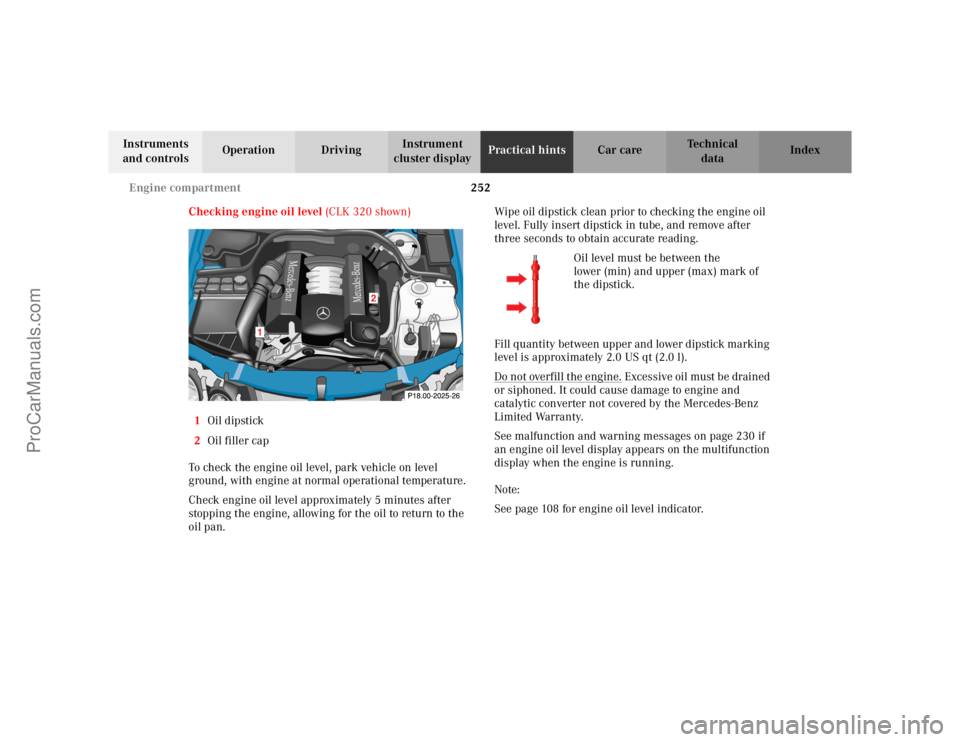
252 Engine compartment
Te ch n i c a l
data Instruments
and controlsOperation DrivingInstrument
cluster displayPractical hintsCar care Index
Checking engine oil level (CLK 320 shown)
1Oil dipstick
2Oil filler cap
To check the engine oil level, park vehicle on level
ground, with engine at normal operational temperature.
Check engine oil level approximately 5 minutes after
stopping the engine, allowing for the oil to return to the
oil pan.Wipe oil dipstick clean prior to checking the engine oil
level. Fully insert dipstick in tube, and remove after
three seconds to obtain accurate reading.
Oil level must be between the
lower (min) and upper (max) mark of
the dipstick.
Fill quantity between upper and lower dipstick marking
level is approximately 2.0 US qt (2.0 l).
Do not overfill the engine.
Excessive oil must be drained
or siphoned. It could cause damage to engine and
catalytic converter not covered by the Mercedes-Benz
Limited Warranty.
See malfunction and warning messages on page 230 if
an engine oil level display appears on the multifunction
display when the engine is running.
Note:
See page 108 for engine oil level indicator.
Mercedes-Benz
Mercedes-Benz
2
1
ProCarManuals.com
Page 256 of 341
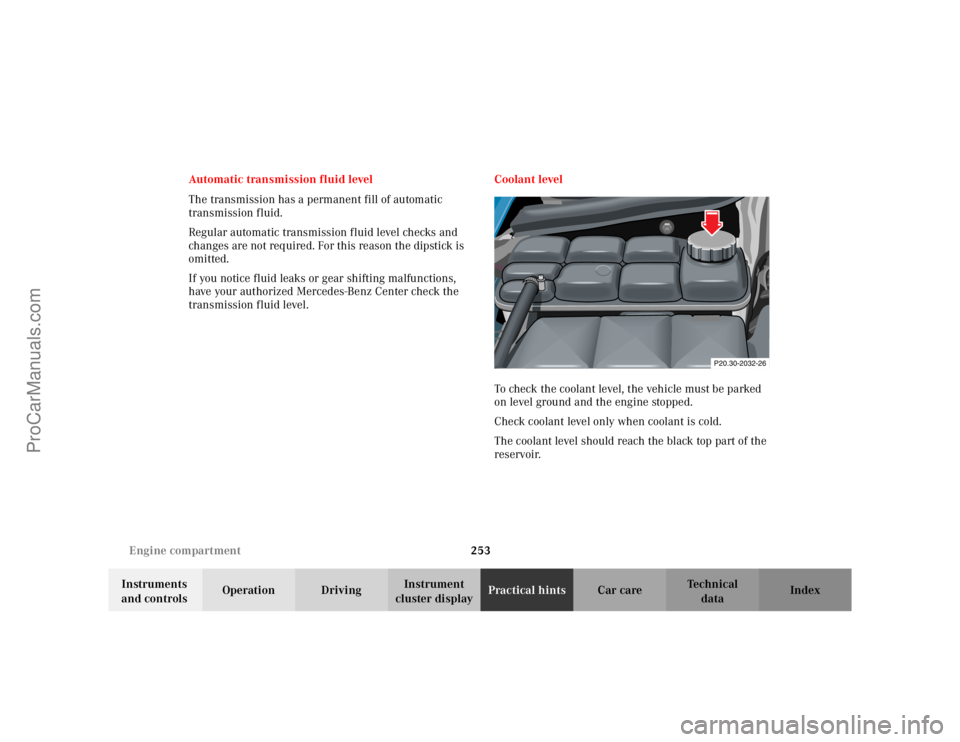
253 Engine compartment
Te ch n i c a l
data Instruments
and controlsOperation DrivingInstrument
cluster displayPractical hintsCar care Index Automatic transmission fluid level
The transmission has a permanent fill of automatic
transmission fluid.
Regular automatic transmission fluid level checks and
changes are not required. For this reason the dipstick is
omitted.
If you notice fluid leaks or gear shifting malfunctions,
have your authorized Mercedes-Benz Center check the
transmission fluid level.Coolant level
To check the coolant level, the vehicle must be parked
on level ground and the engine stopped.
Check coolant level only when coolant is cold.
The coolant level should reach the black top part of the
reservoir.
P20.30-2032-26
ProCarManuals.com
Page 273 of 341
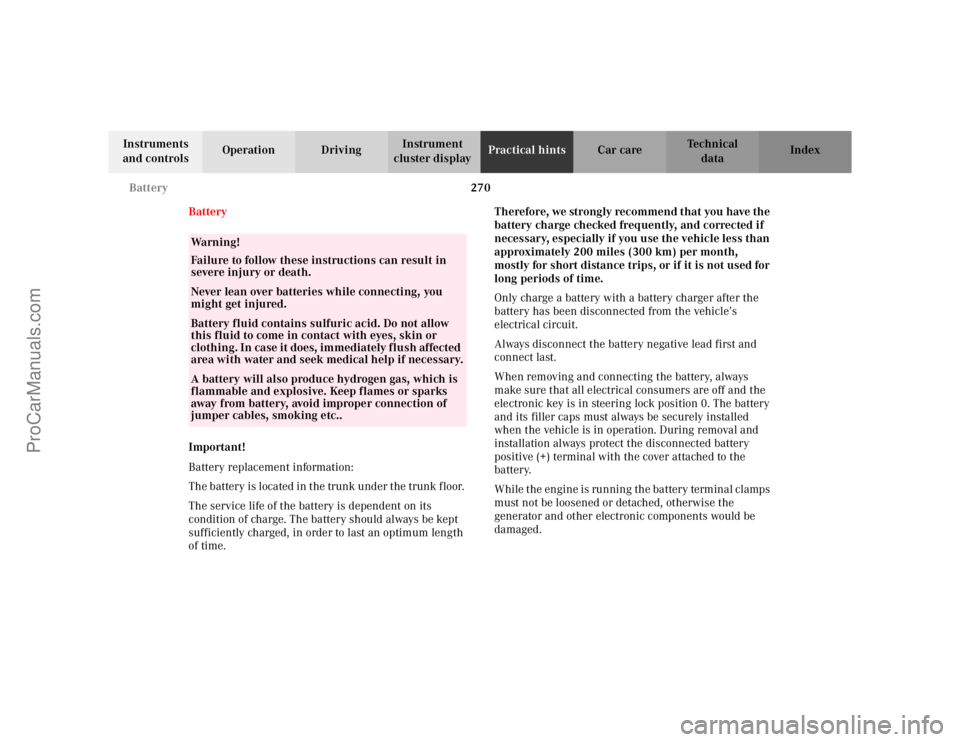
270 Battery
Te ch n i c a l
data Instruments
and controlsOperation DrivingInstrument
cluster displayPractical hintsCar care Index
Battery
Important!
Battery replacement information:
The battery is located in the trunk under the trunk floor.
The service life of the battery is dependent on its
condition of charge. The battery should always be kept
sufficiently charged, in order to last an optimum length
of time.Therefore, we strongly recommend that you have the
battery charge checked frequently, and corrected if
necessary, especially if you use the vehicle less than
approximately 200 miles (300 km) per month,
mostly for short distance trips, or if it is not used for
long periods of time.
Only charge a battery with a battery charger after the
battery has been disconnected from the vehicle’s
electrical circuit.
Always disconnect the battery negative lead first and
connect last.
When removing and connecting the battery, always
make sure that all electrical consumers are off and the
electronic key is in steering lock position 0. The battery
and its filler caps must always be securely installed
when the vehicle is in operation. During removal and
installation always protect the disconnected battery
positive (+) terminal with the cover attached to the
battery.
While the engine is running the battery terminal clamps
must not be loosened or detached, otherwise the
generator and other electronic components would be
damaged.
Wa r n i n g !
Failure to follow these instructions can result in
severe injury or death.Never lean over batteries while connecting, you
might get injured.Battery fluid contains sulfuric acid. Do not allow
this fluid to come in contact with eyes, skin or
clothing. In case it does, immediately flush affected
area with water and seek medical help if necessary.A battery will also produce hydrogen gas, which is
flammable and explosive. Keep flames or sparks
away from battery, avoid improper connection of
jumper cables, smoking etc..
ProCarManuals.com
Page 276 of 341

273 Towing
Te ch n i c a l
data Instruments
and controlsOperation DrivingInstrument
cluster displayPractical hintsCar care Index Important!
5. Start engine of the vehicle with the charged battery
and run at high idle. Make sure the cables are not
on or near pulleys, fans, or other parts that move
when the engine is started. Allow the discharged
battery to charge for a few minutes. Start engine of
the disabled vehicle in the usual manner.
6. After the engine has started, remove jumper cables
by exactly reversing the above installation
sequence, starting with the last connection made
first. When removing each clamp, make sure that it
does not touch any other metal while the other end
is still attached to a battery.
Notes:
If engine does not run after several unsuccessful
starting attempts, have it checked at the nearest
authorized Mercedes-Benz Center.
Excessive unburned fuel generated by repeated failed
starting attempts may damage the catalytic converter.Tow i n g t h e v e h i c l e
Mercedes-Benz recommends that the vehicle be
transported with all wheels off the ground using flatbed
or appropriate wheel lift/ dolly equipment. This method
is preferable to other types of towing.
Caution!
Use flatbed or wheel lift/ dolly equipment with key in
steering lock turned to position 0.
Do not tow with sling- type equipment. Towing with
sling- type equipment over bumpy roads will damage
radiator and supports.
To prevent damage during transport, do not tie down
vehicle by its chassis or suspension parts.
Switch off the tow-away alarm (see page 40) as well as
the ESP (see page 218).
When circumstances do not permit the recommended
towing methods, the vehicle may be towed with all
wheels on the ground or front wheels raised only so far
as necessary to have the vehicle moved to a safe location
where the recommended towing methods can be
employed.
ProCarManuals.com
Page 324 of 341
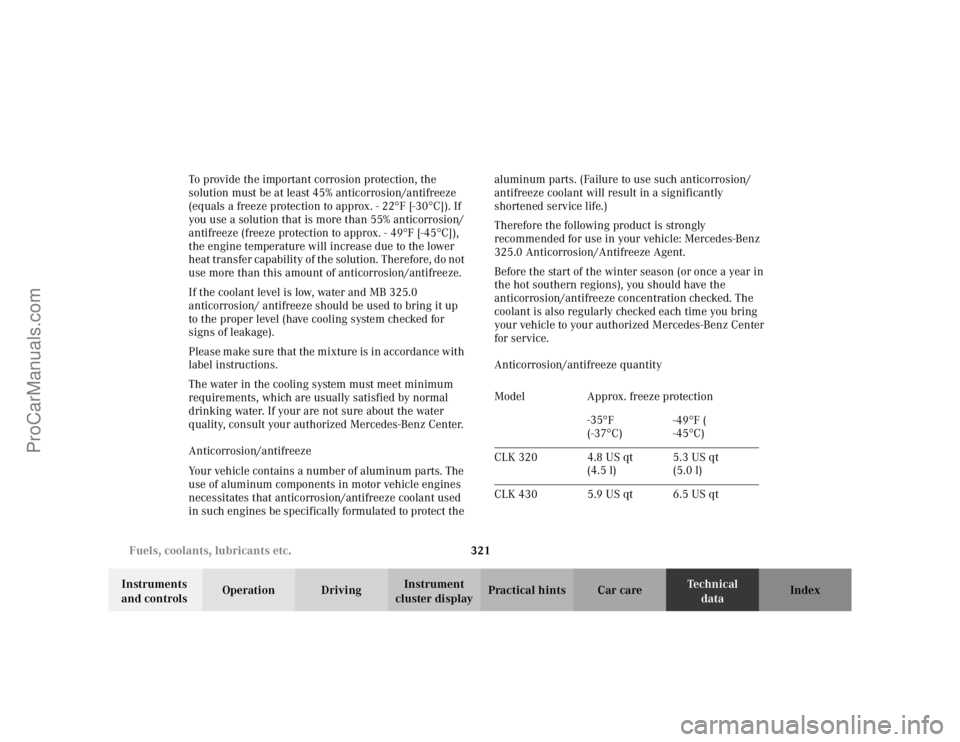
321 Fuels, coolants, lubricants etc.
Te ch n i c a l
data Instruments
and controlsOperation DrivingInstrument
cluster displayPractical hints Car care Index To provide the important corrosion protection, the
solution must be at least 45% anticorrosion/antifreeze
(equals a freeze protection to approx. - 22
°F [-30
°C]). If
you use a solution that is more than 55% anticorrosion/
antifreeze (freeze protection to approx. - 49
°F [-45
°C]),
the engine temperature will increase due to the lower
heat transfer capability of the solution. Therefore, do not
use more than this amount of anticorrosion/antifreeze.
If the coolant level is low, water and MB 325.0
anticorrosion/ antifreeze should be used to bring it up
to the proper level (have cooling system checked for
signs of leakage).
Please make sure that the mixture is in accordance with
label instructions.
The water in the cooling system must meet minimum
requirements, which are usually satisfied by normal
drinking water. If your are not sure about the water
quality, consult your authorized Mercedes-Benz Center.
Anticorrosion/antifreeze
Your vehicle contains a number of aluminum parts. The
use of aluminum components in motor vehicle engines
necessitates that anticorrosion/antifreeze coolant used
in such engines be specifically formulated to protect the aluminum parts. (Failure to use such anticorrosion/
antifreeze coolant will result in a significantly
shortened service life.)
Therefore the following product is strongly
recommended for use in your vehicle: Mercedes-Benz
325.0 Anticorrosion/Antifreeze Agent.
Before the start of the winter season (or once a year in
the hot southern regions), you should have the
anticorrosion/antifreeze concentration checked. The
coolant is also regularly checked each time you bring
your vehicle to your authorized Mercedes-Benz Center
for service.
Anticorrosion/antifreeze quantity
Model Approx. freeze protection
-35
°F
(-37°C)-49
°F (
-45°C)
CLK 320 4.8 US qt
(4.5 l)5.3 US qt
(5.0 l)
CLK 430 5.9 US qt 6.5 US qt
ProCarManuals.com
Page 329 of 341
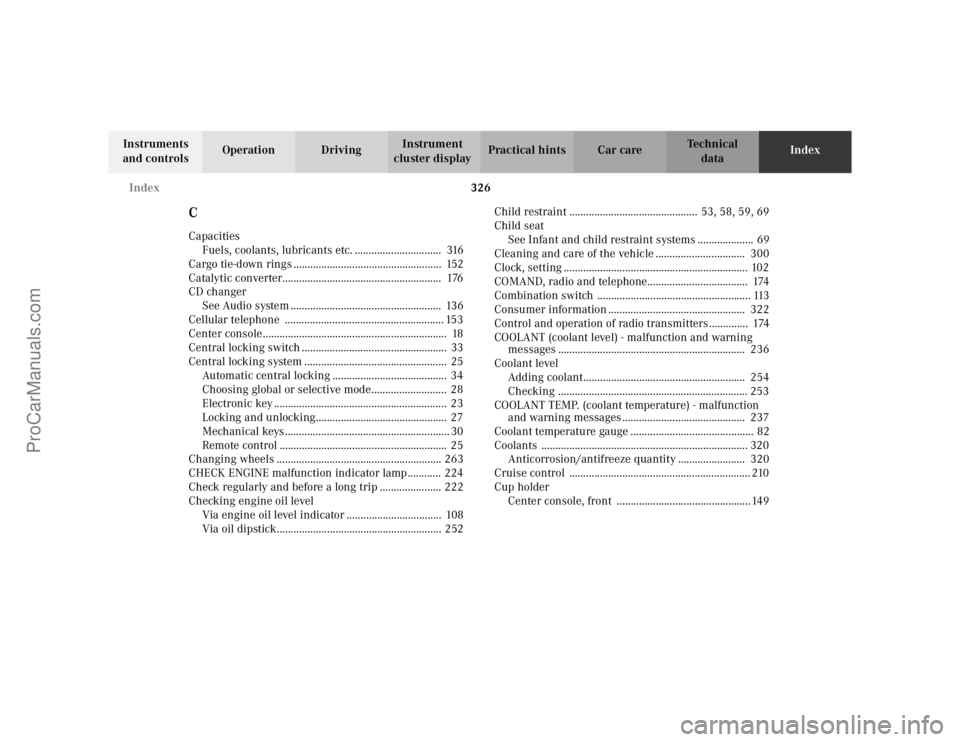
326 Index
Te ch n i c a l
data Instruments
and controlsOperation DrivingInstrument
cluster displayPractical hints Car careIndex
CCapacities
Fuels, coolants, lubricants etc. ............................... 316
Cargo tie-down rings ..................................................... 152
Catalytic converter......................................................... 176
CD changer
See Audio system ...................................................... 136
Cellular telephone ......................................................... 153
Center console .................................................................. 18
Central locking switch .................................................... 33
Central locking system ................................................... 25
Automatic central locking ......................................... 34
Choosing global or selective mode........................... 28
Electronic key .............................................................. 23
Locking and unlocking............................................... 27
Mechanical keys ........................................................... 30
Remote control ............................................................ 25
Changing wheels ........................................................... 263
CHECK ENGINE malfunction indicator lamp............ 224
Check regularly and before a long trip ...................... 222
Checking engine oil level
Via engine oil level indicator .................................. 108
Via oil dipstick........................................................... 252Child restraint .............................................. 53, 58, 59, 69
Child seat
See Infant and child restraint systems .................... 69
Cleaning and care of the vehicle ................................ 300
Clock, setting .................................................................. 102
COMAND, radio and telephone.................................... 174
Combination switch ....................................................... 113
Consumer information ................................................. 322
Control and operation of radio transmitters .............. 174
COOLANT (coolant level) - malfunction and warning
messages ................................................................... 236
Coolant level
Adding coolant.......................................................... 254
Checking .................................................................... 253
COOLANT TEMP. (coolant temperature) - malfunction
and warning messages ............................................ 237
Coolant temperature gauge ............................................ 82
Coolants .......................................................................... 320
Anticorrosion/antifreeze quantity ........................ 320
Cruise control ................................................................. 210
Cup holder
Center console, front ................................................ 149
ProCarManuals.com
Page 330 of 341
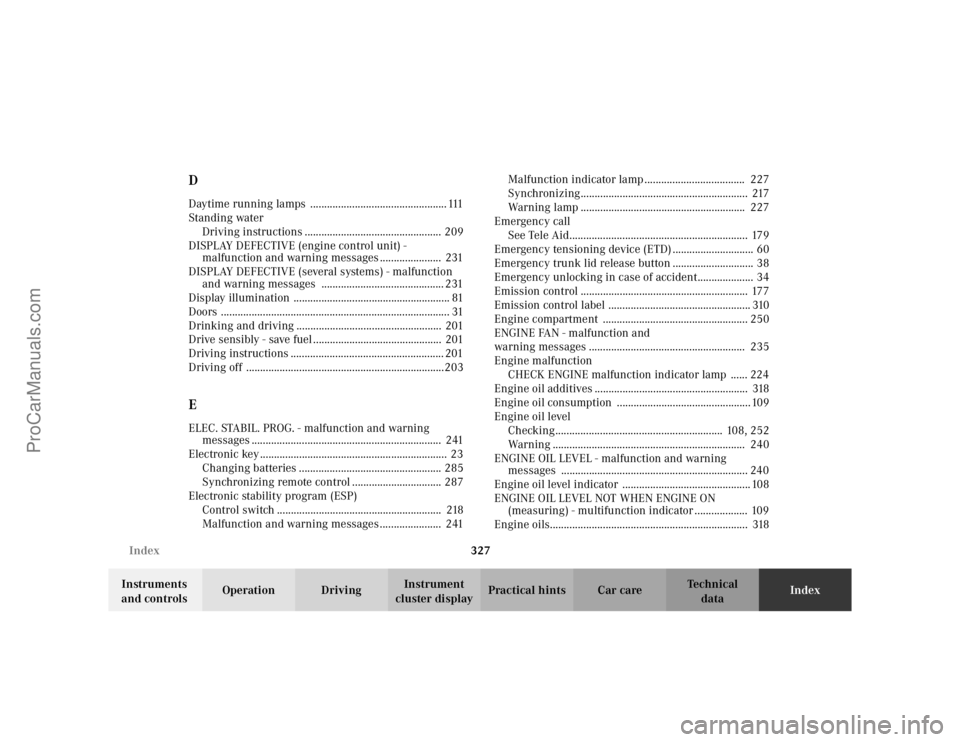
327 Index
Te ch n i c a l
data Instruments
and controlsOperation DrivingInstrument
cluster displayPractical hints Car careIndex
DDaytime running lamps ................................................. 111
Standing water
Driving instructions ................................................. 209
DISPLAY DEFECTIVE (engine control unit) -
malfunction and warning messages ...................... 231
DISPLAY DEFECTIVE (several systems) - malfunction
and warning messages ............................................ 231
Display illumination ........................................................ 81
Doors .................................................................................. 31
Drinking and driving .................................................... 201
Drive sensibly - save fuel .............................................. 201
Driving instructions ....................................................... 201
Driving off .......................................................................203EELEC. STABIL. PROG. - malfunction and warning
messages .................................................................... 241
Electronic key ................................................................... 23
Changing batteries ................................................... 285
Synchronizing remote control ................................ 287
Electronic stability program (ESP)
Control switch ........................................................... 218
Malfunction and warning messages ...................... 241Malfunction indicator lamp .................................... 227
Synchronizing............................................................ 217
Warning lamp ........................................................... 227
Emergency call
See Tele Aid................................................................ 179
Emergency tensioning device (ETD) ............................. 60
Emergency trunk lid release button ............................. 38
Emergency unlocking in case of accident.................... 34
Emission control ............................................................ 177
Emission control label ................................................... 310
Engine compartment .................................................... 250
ENGINE FAN - malfunction and
warning messages ........................................................ 235
Engine malfunction
CHECK ENGINE malfunction indicator lamp ...... 224
Engine oil additives ....................................................... 318
Engine oil consumption ................................................ 109
Engine oil level
Checking............................................................ 108, 252
Warning ..................................................................... 240
ENGINE OIL LEVEL - malfunction and warning
messages ................................................................... 240
Engine oil level indicator .............................................. 108
ENGINE OIL LEVEL NOT WHEN ENGINE ON
(measuring) - multifunction indicator ................... 109
Engine oils....................................................................... 318
ProCarManuals.com